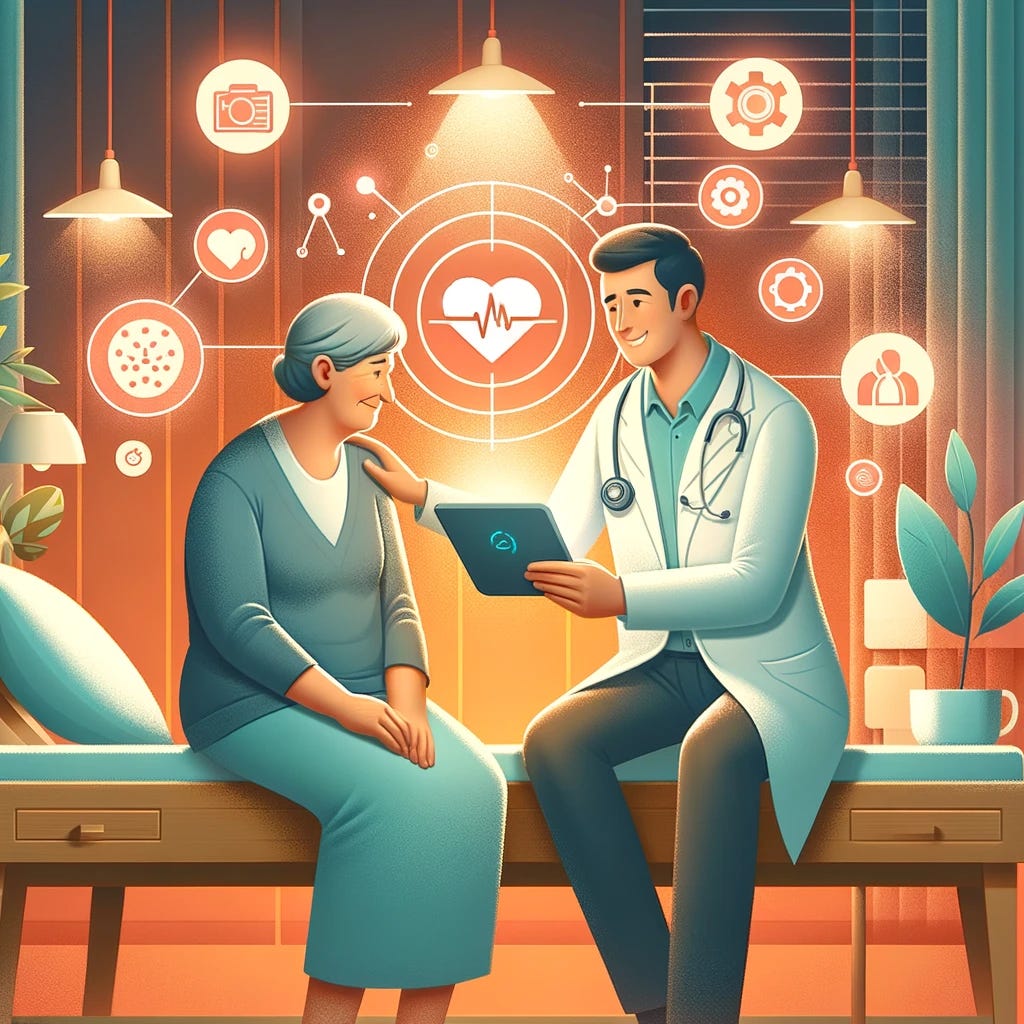AI and the Path To Making Medicine Human Again
Table of Contents
- The Time Drain
- The Increasing Burden on Doctors
- The AI breakthrough
- AI In Diagnostics
- Misconceptions and Fears
- The Overall Vision of AI in Medicine
- Liberating Doctors from the Keyboard
- Enhanced Patient Engagement
- Keeping Physicians Informed
- Addressing Ethical and Privacy Concerns
- The Need for Validation
- Concluding Thoughts

The Burnout Epidemic in Modern Medicine: The Administrative Quagmire
Media is obsessed these days with all things AI, and the integration of AI in healthcare is no exception. Artificial intelligence in healthcare has multiple advantages. It’s important, however, to analyze what the issues in modern healthcare are to better understand where this new technology will be deployed. The advent of Healthcare 2.0, driven by the development of electronic medical records (EMRs) and digitalization and technological integration, was meant to herald a new era of efficiency in medical practice. However, this transition has shackled physicians with overwhelming administrative tasks, overshadowing patient care. This burden is not just a minor inconvenience; it impairs the quality of healthcare delivery. About a decade ago, the introduction of Electronic Health Records (EHR) began to encroach upon the personal time of physicians, including weekends and vacations.Physicians, on average, spend an alarming 24% of their working hours on administrative duties, with primary care physicians and women reporting even higher percentages. The implications of this are grave, as two-thirds of the respondents in a survey reported that administrative duties negatively affect their ability to deliver high-quality care. Furthermore, those spending more time on administrative tasks reported lower levels of career satisfaction, higher levels of burnout, and a greater likelihood of reducing patient interactions in the future.
The Increasing Burden on Doctors
All this happens as the global population expands and ages and the healthcare sector is witnessing an unprecedented surge in patient numbers as well as complexity; the average patient is just sicker than they used to be.
Factors like the obesity epidemic, the opioid epidemic, and the financial crisis after the financial crisis are key contributors to this trend. For example, the incidence of diabetes is expected to increase by 53% between 2003 and 2023.
Primary Care Providers (PCPs) are particularly impacted, as they often care for complex patients with multidimensional needs, including socio-economic, medical, and mental health challenges. However, they also face significant barriers at both local and larger healthcare system levels, including payment systems, insurance issues, poor access to mental healthcare, and fragmentation of care as patients need more and more specialist interactions and more physician hours. This situation calls for a more integrated approach to healthcare and a shift in the way we process the overwhelming amount of data and information each patient creates.
The Artificial Intelligence breakthrough
Artificial Intelligence (AI) is poised to drastically alleviate the administrative burdens that have led to physicians feeling like data clerks. Currently, the time doctors spend on tasks like scribing, chart review, and medication reconciliation can be done quicker and better by emerging generative AI technologies. AI algorithms are being developed to serve as virtual scribes, transcribing doctor-patient conversations into the electronic medical record, reducing the time spent on manual documentation. UCSF Health plans to implement AI scribing tools within the next year or two to liberate clinicians from the keyboard and refocus them on patient interaction.
In chart review, AI can efficiently parse patient histories, extracting and highlighting vital information. This automation cuts down on the time doctors spend reviewing and updating patient charts and can maximize the time doctors can actually spend with their patients. Similarly, in medication reconciliation, AI systems can check for drug interactions and prescription inconsistencies, recommend preventative care measures, and make sure clinical care is in line with the cutting-edge and gold standard of patient care. AI can also improve physician productivity by automating routine tasks such as billing, appointment scheduling, and facility management. It has the potential to enhance patient engagement, personalize communication, and answer patient questions, leading to improved patient satisfaction.
AI In Diagnostics
AI can also improve healthcare quality by improving diagnostic ability—numerous studies and trials demonstrate the practical applications of AI in healthcare. For instance, a deep-learning computer-aided detection system has shown effectiveness in cancer detection during colonoscopy. This study, published in Lancet Gastroenterol Hepatol, highlights AI’s potential in improving gastroenterology diagnostic procedures.
Another notable example is the use of stimulated Raman histology and deep neural networks for near real-time intraoperative brain tumor diagnosis, as published in Nature Medicine. This approach represents a significant advancement in the speed and accuracy of cancer diagnosis during surgical procedures.
In dermatology, an AI algorithm has been developed to detect melanoma in images of skin lesions, demonstrating AI’s potential in early and accurate skin cancer detection. This was reported in a study published in JAMA Network Open.
Misconceptions and Fears
There are growing misconceptions and fears, particularly concerning the potential of AI to replace human physicians. This concern, while understandable, often overlooks AI’s role as a supportive tool rather than a replacement for human expertise. All the applications of AI so far require keeping a human in the loop and really serve as cognitive enhancers for clinicians. AI’s primary function should be viewed in healthcare as augmenting the capabilities of medical professionals, not supplanting them. For example, AI algorithms in diagnostic imaging enhance radiologists’ ability to detect anomalies more quickly and accurately but do not replace the need for a radiologist’s expert interpretation and judgment.
Ethical implications are also at the forefront of the AI healthcare debate. Issues such as decision-making authority and patient privacy are critical concerns. AI systems make recommendations based on data, but the ultimate decision-making responsibility remains with the human healthcare providers. This is crucial in maintaining the human element in medicine, where empathy and ethical considerations play a significant role.
The Overall Vision of AI in Medicine
The transformative role of AI in medicine aims not to replace doctors but to enhance their capabilities, focusing on improving patient care outcomes and reintroducing humanity into medical practice. Championed by experts like cardiologist Eric Topol, this integration is pivotal in achieving ‘keyboard liberation,’ freeing physicians from the heavy load of administrative tasks. Advanced AI applications in medical documentation, error reduction in data collection, and improved medication reconciliation processes enable doctors to focus more on patient-centered care, enhancing the doctor-patient relationship and overall healthcare quality. This shift is expected to significantly reduce burdensome tasks, allowing doctors more time for direct patient care.
Enhanced Patient Engagement
One of the key aspects of AI in healthcare is its ability to streamline and improve patient-provider communication. AI tools are being utilized to translate medical jargon into patient-friendly language or other languages entirely, thereby making healthcare communication more accessible for patients with limited English proficiency.
Furthermore, AI-driven tools are demonstrating the capability to summarize vast amounts of medical information, making it more understandable for patients. This ability to distill multi-page discharge plans into a concise and comprehensible format is crucial for patient understanding. Such capabilities significantly enhance the likelihood of patients comprehending their healthcare situations and the actions they need to undertake, along with the rationale for these actions and the next steps to expect from their care team.
In addition to improving communication, AI-tailored engagement helps patients better adhere to their care plans and medications. AI also enables health systems to proactively reach out to patients to address their care needs, thereby creating a more “always on” care environment. For example, AI tools can identify patients who haven’t engaged with primary care or wellness visits and encourage them to schedule appointments through AI-driven online scheduling options. This proactive engagement is essential for maintaining patient health and preventing unnecessary utilization.
Keeping Physicians Informed
AI technologies are revolutionizing the way physicians monitor and manage patient health, significantly increasing the efficiency of patient care. With the integration of AI, physicians can potentially manage a much larger number of patients, up to ten times their current capacity, by utilizing advanced data analysis and monitoring tools.
One of the most promising aspects of AI in healthcare is its application in conjunction with wearable technology. Wearable devices equipped with various sensors can continuously monitor vital health parameters like heart rate, blood pressure, respiratory rate, and even more complex data such as atrial fibrillation (AFib) episodes and sleep patterns. The integration of AI helps in the interpretation of this vast amount of data, providing physicians with actionable insights and timely alerts.
For instance, AI can analyze data from wearable devices to provide earlier and more accurate predictions and diagnoses of heart diseases. AI’s capability to sift through and analyze large volumes of data from wearable devices makes it an invaluable tool in proactive health monitoring and disease prevention.
The Need for Validation
Realistic and robust clinical validation is essential for AI tools to be effectively integrated into healthcare; for clinicians to use AI, they need to trust it. Realistic and robust clinical validation is critical for effectively integrating AI tools into healthcare. This process involves:
- Rigorously testing AI algorithms against large and diverse datasets.
- Comparing their performance to other standard tools.
- Ensuring that the technology functions reliably across different patient populations.
Clinical validation ensures that AI tools can serve as a significant cognitive aid for physicians, enhancing their decision-making processes and patient care.
Concluding Thoughts
AI holds the potential to revolutionize healthcare, but its implementation must be ethical, responsible, and aimed at enhancing accessibility to care. It’s crucial to ensure that AI does not exacerbate existing healthcare disparities but rather contributes to a more equitable healthcare system. Ironically, I am incredibly optimistic that AI will improve healthcare and make it more human again.










